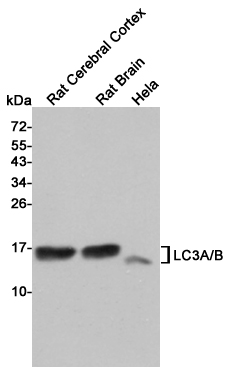-
Product Name
Anti-LC3A/B (3E9) Mouse antibody
- Documents
-
Description
LC3A/B (3E9) Mouse monoclonal antibody
-
Tested applications
WB
-
Species reactivity
Human, Rat
-
Alternative names
ATG8F; Autophagy related protein LC3 A; Autophagy related protein LC3 B; Autophagy related ubiquitin like modifier LC3 A; Autophagy related ubiquitin like modifier LC3 B; Autophagy-related protein LC3 B; Autophagy-related ubiquitin-like modifier LC3 B; LC antibody
-
Isotype
Mouse IgG2b
-
Preparation
Antigen: Synthetic peptide corresponding to human LC3B protein
-
Clonality
Monoclonal
-
Formulation
PBS(pH 7.4) containing with 0.03% Proclin300 and 50% glycerol.
-
Storage instructions
Store at 4°C short term. Store at -20°C long term. Avoid freeze / thaw cycle.
-
Applications
WB: 1/1000
-
Validations

Western blot detection of LC3A/B in Rat Cerebral Cortex,Rat Brain and Hela cell lysates using LC3A/B Mouse mAb (1:1000 diluted). Predicted band size: 15KDa. Observed band size:14, 16KDa.
-
Background
Swiss-Prot Acc.Q9H492,Q9GZQ8.Macroautophagy is the major inducible pathway for the general turnover of cytoplasmic constituents in eukaryotic cells, it is also responsible for the degradation of active cytoplasmic enzymes and organelles during nutrient starvation. Macroautophagy involves the formation of double-membrane bound autophagosomes which enclose the cytoplasmic constituent targeted for degradation in a membrane bound structure, which then fuse with the lysosome (or vacuole) releasing a single-membrane bound autophagic bodies which are then degraded within the lysosome (or vacuole). MAP1A and MAP1B are microtubule-associated proteins which mediate the physical interactions between microtubules and components of the cytoskeleton. These proteins are involved in formation of autophagosomal vacuoles (autophagosomes). MAP1A and MAP1B each consist of a heavy chain subunit and multiple light chain subunits. MAP1LC3a is one of the light chain subunits and can associate with either MAP1A or MAP1B. The precursor molecule is cleaved by APG4B/ATG4B to form the cytosolic form, LC3-I. This is activated by APG7L/ATG7, transferred to ATG3 and conjugated to phospholipid to form the membrane-bound form, LC3-II.
Related Products / Services
Please note: All products are "FOR RESEARCH USE ONLY AND ARE NOT INTENDED FOR DIAGNOSTIC OR THERAPEUTIC USE"
